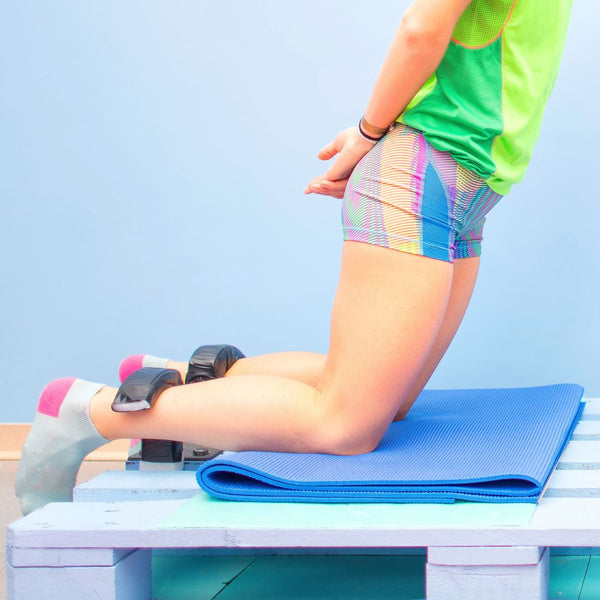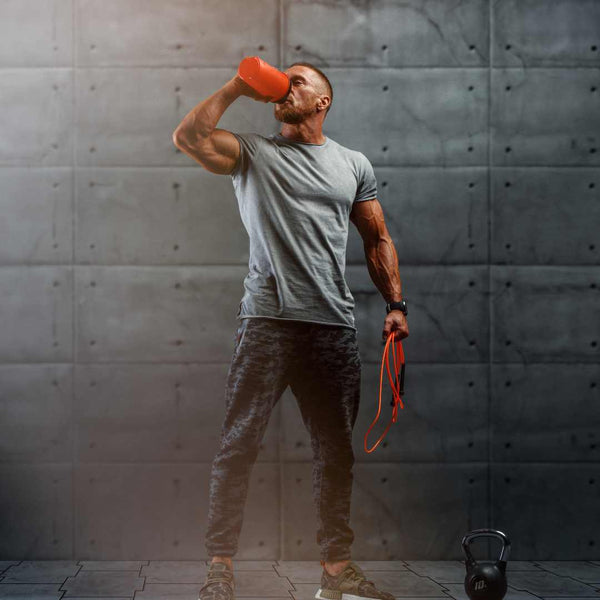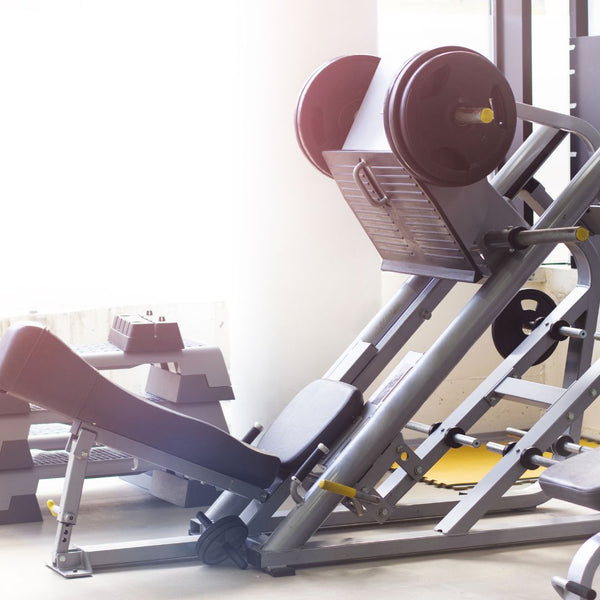Training the semitendinosus muscle is going to increase performance, increase strength and decrease injury. Isolating the semitendinosus muscle from your other hamstring muscles is impossible, but you can do exercises that favor it. Further, knowing your body’s anatomy and function will only improve your training.
This article will lay out the best semitendinosus exercises you can use to ensure you’re training the whole hamstring in the most efficient way possible.
What Is The Semitendinosus Muscle?
Your hamstring muscles are one of the most powerful muscle groups in the human body. Collectively, this muscle group comprises three different muscles that work together to extend the hips and flex the knees. The three muscles are:
- Biceps Femoris: Sits on the lateral side of the posterior upper thigh. Of the three hamstring muscles, it is the only two-headed muscle composed of a long head and a short head (biceps). It’s also the strongest muscle of the hamstrings. Try the best biceps femoris exercises!
- Semimembranosus: Sits on the medial side of the upper thigh and deep to the semitendinosus. It’s the one most often forgotten.
- Semitendinosus: Stands out from the unusually long tendon at its knee insertion point, making it a unique part of your hamstring group. This is also where its name is derived.
We’ll now dig into the semitendinosus and the exercises you need to train it.
3 Benefits of Semitendinosus Exercises
Your hamstrings are a crucial muscle involved in health and performance. Whether you’re an athlete, lifter, or just a regular person wanting to maintain health and mobility, here are the reasons you need to strengthen your hamstrings.
1. Prevent Injury
Most athletes have some experience pulling a hamstring. Maybe you haven’t straight-up snapped the muscle, but most athletes have had some issue with a minor strain, usually while sprinting.
Hamstring injuries, which account for 12-16% of all sports injuries, can be significantly reduced with stronger hamstrings.¹ The high reinjury rate of 22-34% underscores this importance, making it clear that stronger hamstrings are crucial for injury prevention.
While the biceps femoris is responsible for the most injuries, a stronger overall hamstring and semitendinosus will still help mitigate problems and even speed up recovery.
2. Improve Performance
A stronger semitendinosus muscle makes for a stronger and faster athlete. This muscle extends your hips and flexes your knee, which is involved in just about every movement you make.
For example, we know that stronger hamstring muscles are related to:
- Faster sprinting
- Faster acceleration
- Stronger squats
- Stronger deadlifts
- Higher force production
You can not improve in athletics and performance without a stronger set of hamstrings.
3. Improve Muscular Imbalances
Muscular imbalance, a condition in which the strength of agonist and antagonist muscles is mismatched, can lead to joint instability. The quadriceps, the agonist/antagonist muscle opposite the hamstrings, plays a key role in this imbalance.
When these two muscles are balanced, they provide optimal stability to the knee and hip. For example:
- In Hip Extension: When the hamstrings (agonist) contract to facilitate hip extension, the quadriceps (antagonist) lengthen to support the movement.
- In Hip Flexion: When the quadriceps (agonist) contract for hip flexion, the hamstrings (antagonist) lengthen to help balance this action.
Regardless, the ideal balance between the hamstring and quadriceps should be 3:4 or 75%. In other words, if your quadricep can produce 400 lbs, your hamstring should be able to produce 300 lbs. However, in the majority of people, their hamstrings are significantly weaker. This means that weak hamstrings don’t just mean you have a higher risk of injury to the hamstrings but a higher risk of injury to:
- Knees
- Gait imbalance
- Hip issues
This has been seen to occur when the hamstring to quadricep strength ratio is less than 60%.² This means that when you’re training your legs, you may want to spend more time on your hamstrings.
The semitendinosus exercises we cover below will help you do that.
4 Best Semitendinosus Exercises
As mentioned, the semitendinosus is one of the three hamstring exercises that work in unison, so it’s impossible to isolate it. Further, it doesn’t really have any very specific secondary functions. In other words, there aren’t any exercises that specifically target the semitendinosus to a high degree.
But this doesn’t mean there aren’t awesome semitendinosus exercises to strengthen it along with your hamstrings! Here are the top semitendinosus exercises to build mass and strength.
1. Nordic Curl
The Nordic curl used to be an odd exercise known only in sports performance and injury prevention. However, its reputation as one of the best exercises for increasing hamstring strength led to its use worldwide.
It consists of getting on your knees, locking your ankles, or having a friend hold them down. You then let your body come down slowly as far as you can until you drop.
The Nordic curl is a fantastic exercise for training the hamstrings as a whole. It has been used extensively in athletics and even rehab and prehab. Studies have shown that this exercise activates the semitendinosus in most of the three hamstring exercises.³
How To Perform The Nordic Curl
- Kneel with your knees about hip-width apart while keeping your torso upright and engage your core.
- With your hips extended and your body straight from your knees to your shoulders, brace your core.
- Slowly lean your torso forward while keeping your hips extended. Your knees should remain in place, and your descent should be controlled. Go as low as you can while maintaining good form.
- Stop at that point if you can’t go further without losing form or control.
- Use your hamstrings to then pull yourself back up to the starting position. This movement requires significant strength and control. If you can’t pull yourself back, you can use your hands to help.
- As you come up, many people will want to flex their hips, push them back, and then extend them. Therefore, focus on driving your hips forward to assist the hamstrings in returning to the upright position.
2. Glute Ham Raise (GHD Machine)
The Glute Ham Developer machine, or GHD, is an awesome piece of equipment that isn’t nearly used enough. It became much more popular with the rise of CrossFit, as it is performed extensively in the sport.
One of the exercises you can perform on these is the glute ham raise. It’s pretty similar to the Nordic curl in terms of biomechanics. The main difference is that you actually hit the hamstrings from both sides with hip extension and knee flexion.
Now, we don’t have any specific studies that show the semitendinosus sees higher activation in the other hamstring muscles. However, we know it’s an awesome hamstring exercise, and the movement pattern is very similar to that of the Nordic curl.
Therefore, we can guess that the activation will be similar. The worst-case scenario is that you get awesome activation in the semitendinosus, biceps femoris, and semitendinosus muscles.
How To Perform The Glute-Ham Raise (GHD)
- Kneel on the machine with your thighs resting on the pad. Your feet should be firmly secured against the footplate or anchored under the rollers. Keep your body upright and engage your core.
- Start with your body straight from your knees to your shoulders. Your hips should be extended and your core engaged.
- Slowly lower your torso toward the ground by bending at the knees and hips. Keep your back straight and avoid letting it round. Move in a controlled manner to maximize tension in the hamstrings.
- Lower yourself as far as you can while maintaining good form. Ideally, you should lower until your torso is almost parallel to the ground or as low as you can comfortably go without compromising form.
- Push through your heels and contract your hamstrings and glutes to lift your body back up. Focus on using your posterior chain to return to the starting position.
- At the top of the movement, ensure your body is straight and aligned. Avoid using momentum to lift yourself and maintain a controlled motion throughout.
3. Running (Especially Acceleration)
Running is your body’s structural, intended use of running. And by running, we mean running!
This is not a shot at jogging—we think jogging and even brisk walking are incredible ways to improve the endurance of the hamstring muscles and general weight control. However, running at top speeds is a different activity, significantly increasing the hamstrings’ activation.
Interestingly, studies show that the semitendinosus receives higher activation while running at top speeds. While the hamstrings saw greater muscle activation from speeds of 50% intensity and up, the semitendinosus muscle saw significantly higher activation at 75%, 85%, and 95%.? Things specifically took off when accelerating from 85% to 95% intensity.
Tips For Running
- Use distances that allow you to run at top speeds (>75%)
- Play with acceleration drills (run at 50% for 10m, then accelerate to 90% for 10m)
- On acceleration, run repeats, attempting to run as far as you can in 5 seconds.
- Run uphill or an incline on the treadmill.
- Play with resisted sprinting (sled, parachute)
Related: How To Sprint Faster
4. Deficit Romanian Deadlift
As we mentioned at the beginning, all of your classic hamstring exercises are going to hit your semitendinosus really well. However, through research, we did find that some exercises seem to have a larger effect. One of these is the deficit Romanian deadlift.
A group of researchers had participants perform 3 different deadlift variations:
- Romanian deadlift
- Step Romanian deadlift (deficit RDL)
- Stiff leg deadlift
In total, they measured the activity of four different muscles:
- Gluteus Maximus
- Gluteus Medius
- Biceps Femoris
- Semitendinosus
Of the three exercises, the deficit RDL created the most significant level of muscle activation for the semitendinosus muscle. However, there are two other interesting observations.
- The semitendinosus seemed to have greater activation during the deficit RDL when compared to the biceps femoris.
- When the differences between the three exercises are compared for the different muscles, the deficit RDL seems to have had the greatest impact on the semitendinosus.
This means that, according to this study, the deficit RDL appears to be a fantastic exercise for training the semitendinosus.?
Now, suppose you’re lifting or don’t have the mobility/ability to perform a deficit RDL. In that case, you’ll be good at performing the traditional RDL, as it also produces high levels of muscle activation in the semitendinosus.
How To Perform The Romanian Deadlift
- Decide whether to start with the barbell on the ground or elevated. Either way works, but we would like to start elevating it. Load the barbell with your chosen weight plates.
- Set up a sturdy platform to stand on. A very low box works best. If you have nothing else, standing on a plate can work.
- Stand in front of the barbell and grasp it with a double overhand grip, hands shoulder-width apart. If your grip gets fatigued, you can use lifting straps. Let the barbell hang naturally in front of you as you stand tall.
- To start the movement, push your hips back and allow your torso to lean forward. It’s crucial that your knees stay almost stationary with minimal forward movement; letting them come too far forward will reduce tension in your hamstrings.
- Continue lowering the barbell while keeping your shoulder blades retracted to maintain a straight back. Ensure your back remains neutral—avoid hyper-extending. Keep the barbell close to your body.
- Lower until your form starts to break and your back begins to round. There isn’t a specific depth to aim for, but the barbell should typically reach mid-shin height. Remember, the goal isn’t to touch the ground but to maximize tension in your hamstrings and biceps femoris.
- Once you reach your desired depth, drive your hips forward and concentrate on contracting your glutes as you return to the starting position until you are fully upright.
3 Training Methods For Semitendinosus Exercises
Now that you have the best semitendinosus exercises, here are some basic training practices. Utilize this with the exercise above to get the most out of your training.
1. Range of Loads
When training your hamstrings, incorporate a variety of loads. This should include heavy weights (90% or higher), provided your technique is sound. Using heavy weights increases strength and power as well as possibly being more effective at preventing injury.
You should also use moderate loads (8-12 reps) and even higher (15+). These rep schemes will increase muscle growth and endurance.
The hamstrings are powerful muscles that endure prolonged use, so developing maximal strength and endurance is essential to optimizing their function.
2. Eccentric Training
Eccentric training plays a vital role in targeting the semitendinosus, as demonstrated in exercises like the Nordic curl and the Glute-Ham Developer (GHD). Research indicates that eccentric contractions are crucial for muscle growth and development, and they have a particularly significant impact on the semitendinosus and hamstrings compared to other muscle groups.
One effective approach to eccentric training is to prolong the eccentric phase of your lifts, aiming for a duration of four seconds or more. This extended time under tension enhances muscle recruitment and promotes growth.
Another strategy is to use heavier weights while avoiding concentric movements, which places greater emphasis on the eccentric phase and allows the muscles to adapt and strengthen more effectively.
Additionally, focus on lowering an increased weight (+10-15%) as slowly as possible, akin to the movements performed in Nordic curls or GHDs. This controlled descent maximizes your muscles’ time under tension, further stimulating muscle development. By incorporating these techniques, you can significantly enhance your training for the semitendinosus and overall hamstring strength.
Related: Concentric vs Eccentric Muscle Contraction
3. Multi-Method Approach
Resistance training is essential to building strong hamstrings. However, a dynamic approach could produce more pronounced effects. For example, you can do your weight training while also doing some sprint workouts or acceleration drills.
Further, due to the role of the hamstrings and semitendinosus in athletics, using exercises like sled work and resisted sprinting could further improve your results. The exercises require the same basic sprinting mechanics but are done under load.
Final Say On Training The Semitendinosus
Integrate the above exercises and training methods into your overall training, and you won’t have to worry about having a weak semitendinosus. More importantly, be sure to have specific hamstring exercises and train them with the same intensity as any other muscle. Apply progressive overload, and you’ll start to see improvements in your performance and even your aesthetics. Plus, no more pulled hammies!
Check out our full collection of hamstring exercises!
References
- Looney, Austin M., et al. “Proximal Hamstring Ruptures: Treatment, Rehabilitation, and Return to Play.” Current Reviews in Musculoskeletal Medicine, 9 Feb. 2023, https://doi.org/10.1007/s12178-023-09821-7.
- Hamstring to Quadriceps Strength Ratio and Noncontact Leg Injuries: A Prospective Study during One Season.” ResearchGate, www.researchgate.net/publication/236955327_Hamstring_to_quadriceps_strength_ratio_and_noncontact_leg_injuries_A_prospective_study_during_one_season.
- Bourne, Matthew N, et al. “Impact of Exercise Selection on Hamstring Muscle Activation.” British Journal of Sports Medicine, vol. 51, no. 13, 13 May 2016, pp. 1021–1028, https://doi.org/10.1136/bjsports-2015-095739.
- Higashihara, Ayako, et al. “Functional Differences in the Activity of the Hamstring Muscles with Increasing Running Speed.” Journal of Sports Sciences, vol. 28, no. 10, Aug. 2010, pp. 1085–1092, https://doi.org/10.1080/02640414.2010.494308.
- Coratella, Giuseppe, et al. “An Electromyographic Analysis of Romanian, Step-Romanian, and Stiff-Leg Deadlift: Implication for Resistance Training.” International Journal of Environmental Research and Public Health, vol. 19, no. 3, 8 Feb. 2022, p. 1903, https://doi.org/10.3390/ijerph19031903.



